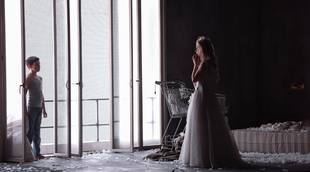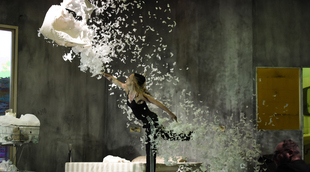 © (c) OFS/Creutziger
© (c) OFS/Creutziger
Italian contemporary composer Salvatore Sciarrino, born in 1947, defined his monodrama Lohengrin as "azione invisibile per solista, strumenti e voci". He expected his work to be an invisible action so to say not to be staged and only presented by a small orchestra dominated by winds, a soprano and three male singers. The new installation of this work by the Salzburg Easter Festival is enriched as a Prelude by two other compositions of Salvatore Sciarrino. La Spazia Inversa, premiered in 1985 at the Venice Biennale. It is a soft spherical sound installation created by a flute, clarinet, celesta, violin and cello. Slow, more swinging than actually moving it is a dialog of the instruments not really interacting which actually enters without interruption into another piece of the composer, "se lamia morte brami" out of his "Gesualdo senza parole", written in 2013 as an honorary to the baroque composer Gesualdo. With the last part of the Prelude further medieval atmosphere arrives from Claudio Monteverdis Lamenta di Ninfa, a masterwork of the Renaissance before the chamber opera itself starts. The libretto has been written by Salvatore Sciarrino. The title might be misleading in regard to a relation to Richard Wagner and the German tales of heroes but some parallels can be located in the weird story.

Lohengrin, Sarah Maria Sun (c) OFS/Creutziger

Lohengrin, Sarah Maria Sun (c) OFS/Creutziger
Elsa is a vestal virgin failing to seduce Lohengrin in the wedding night. He himself escaping on a pillow transformed to a swan. Elsa's mourning reveals her mental illness and life in a psychiatric hospital. The approximately fifty minutes of Elsas monologue have been put on a small stage at the main hall of the Salzburg University by Michael Sturminger, Renate Martin and Andreas Donhauser. Elsa, exceptionally well presented by the German soprano Sarah Maria Sun, appears in a long black dress in her cold room with a big window offering a wide view into a foggy, blending white landscape.
There is not much to sing for Elsa, more of an expressive talking to herself, including the role of Lohengrin, who does not appear. She gasps and moans, hardly sings but floats on stage hanging around with her different visions. She creates and lives in her own world of thoughts, undresses puts on her wedding dress, a pillow is torn and feathers fly around before in the final scene a young boy appears in the open window, holding his own pillow in his hand. There is a long pause, slowly the timid boy approaches Elsa, falling asleep in her bosom to be suffocated by Elsa. This unexpected sequence of actions shakes up the audience after an intense slow motion embedded in cosmic sound creations. Long high tones are stringed together in an harmonic colourful construction without eruption or emotions.
Peter Tilling guides the musicians of the OENM (Oesterreichisches Ensemble fuer Neue Musik) showing their skills in producing the most exotic and utopic sound pictures with their instruments for the inner tortures of Elsa. This puristic stringent concept of the composition is not without effect for the audience which is getting more and more attracted or even touched by the lively and moving monologue of Elsa. Delution swaps to lunacy at the end, revealing Elsas madness but not a convincing solution. It is dense and even hefty offering a deep view into the ill soul of Elsa. There is a short but intense applause for all participants honouring their convincing performance.
Helmut Pitsch
the 04 of May, 2017 | Print
Comments